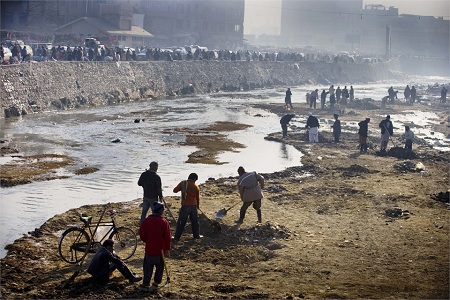
Workers clear out the Kabul river. Kabul's main river has become increasingly polluted over the last few years, and it is currently being dredged. (Photo: Kate Holt/IRIN)
Only 48 percent of Afghanistan’s population have access to safe drinking water and only 37 percent use improved sanitation facilities - with serious health implications, especially for children, according to the UN Children's Fund.
While some parts of the country are physically water scarce, most people lack access to safe water because of inadequate infrastructure and poor management rather than insufficient resources, says a report published by the Centre for Policy and Human Development at Kabul University.
“During three decades of turmoil in Afghanistan, water supply infrastructure has been neglected or destroyed, while the relevant institutions responsible for management and service delivery have collapsed," said the report entitled Afghanistan Human Development Report 2011.
"Around 73 percent of the population relies on improvised and inadequate facilities to supply water, while water sources are becoming increasingly polluted and overexploited in places like Kabul."
Some 70 percent of the urban population live in unplanned areas or in illegal settlements, while 95 percent lack access to improved toilets. In Kabul 80 percent of the population live in unplanned settlements where poor sanitation and lack of access to safe drinking water are common.
This IRIN photogallery looks at the water crisis in Afghanistan.



